Abstract
1. Inhibition of inspiratory muscle activity from volume-related feedback during mechanical ventilation has been shown previously. To determine if this neuromechanical inhibition displays a memory effect, the duration of expiration immediately following cessation of mechanical ventilation was assessed in eight normal subjects. The subjects were passively mechanically ventilated via a nasal mask until the end-tidal CO2 (PET,CO2) was a minimum of 30 mmHg and inspiratory effort was no longer detected, as evidenced by stabilization of mouth pressure and disappearance of surface diaphragm EMG activity. The ventilator output was held constant at a mean tidal volume (VT) of 1.0 l and breath duration of 4.6 s and PET,CO2 was increased 1-1.5 mmHg/min (via increased inspired CO2 fraction, FI,CO2) until inspiratory muscle activity returned. The PET,CO2 at which activation first occurred was defined as the CO2 recruitment threshold (PCO2,RT). The mechanical ventilation protocol was repeated and the PET,CO2 increased 1-1.5 mmHg/min until it was a mean of 1.1 mmHg above spontaneous PET,CO2 and 3.6 mmHg below PCO2,RT. After 4-6 min of mildly hypercapnic mechanical ventilation, the mechanical ventilation was terminated. 2. Following termination of mechanical ventilation, the duration of the subsequent apnoea was 14.6 +/- 2.8 s (mean +/- S.E.M.) or 453 +/- 123% > spontaneous TE and 178 +/- 62% > the TE chosen by the subject during 'assist control' ventilation at VT = 1.0 l. 3. To test the hypothesis that the apnoea following cessation of mechanical ventilation was due to a vagally mediated memory effect, the study was repeated in five double-lung transplant patients with similar PCO2,RT to normal subjects. These pulmonary vagally denervated patients also displayed an apnoea (14.5 +/- 4.0 s) upon cessation of mechanical ventilation (at a PET,CO2 2.0 mmHg > eupnoea and 2.4 mmHg < PCO2,RT), that was 367 +/- 162% > spontaneous TE. 4. We also found significant apnoea in the awake dog immediately following mildly hypercapnic passive mechanical ventilation, and this was similar before and after bilateral vagal blockade (15.7 +/- 1.3 and 19.7 +/- 4.7 s, respectively). 5. We conclude that neuromechanical inhibition of inspiratory muscle activity, produced by passive mechanical ventilation at high VT, exhibits a memory effect reflected in TE prolongation, which persists in the face of substantial increases in chemoreceptor stimuli. This effect is not dependent on vagal feedback from lung receptors. 6. We hypothesize that this persistent apnoea represents an inherent 'inertia', characteristic of the ventilatory control system.(ABSTRACT TRUNCATED AT 400 WORDS)
Full text
PDF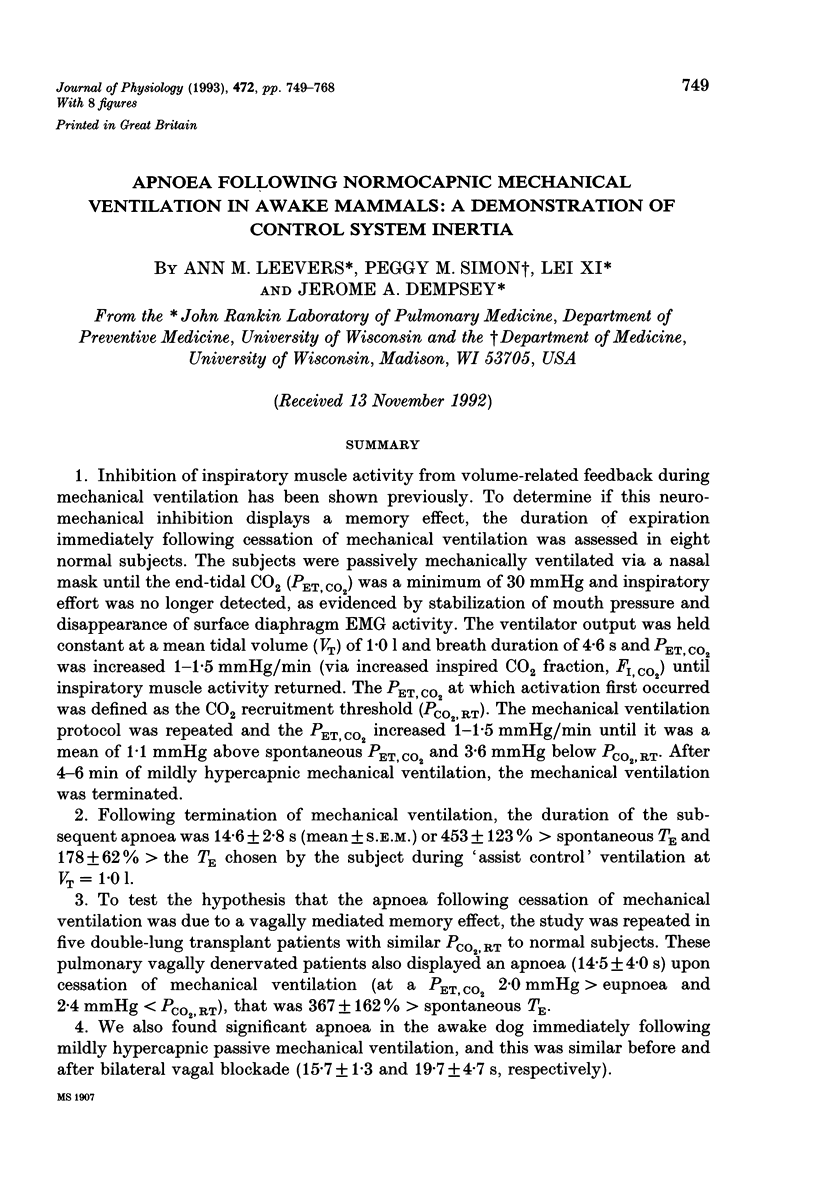
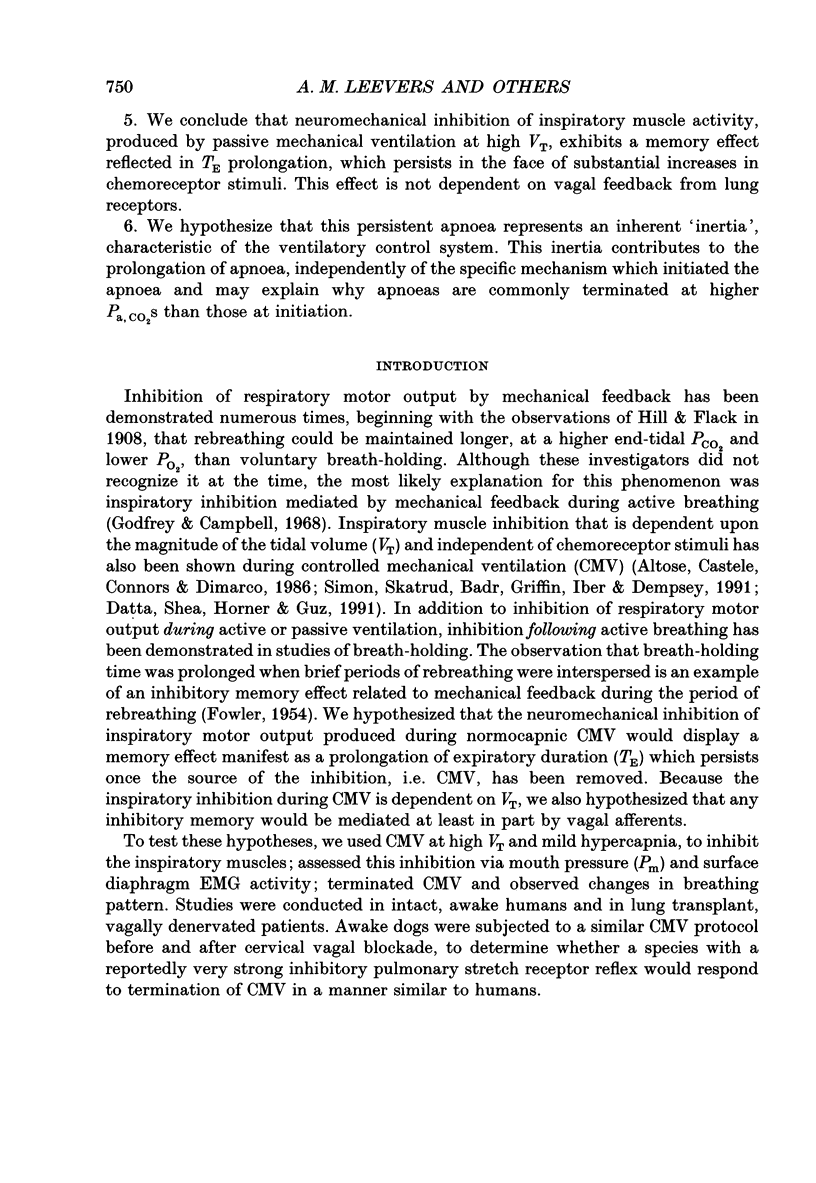
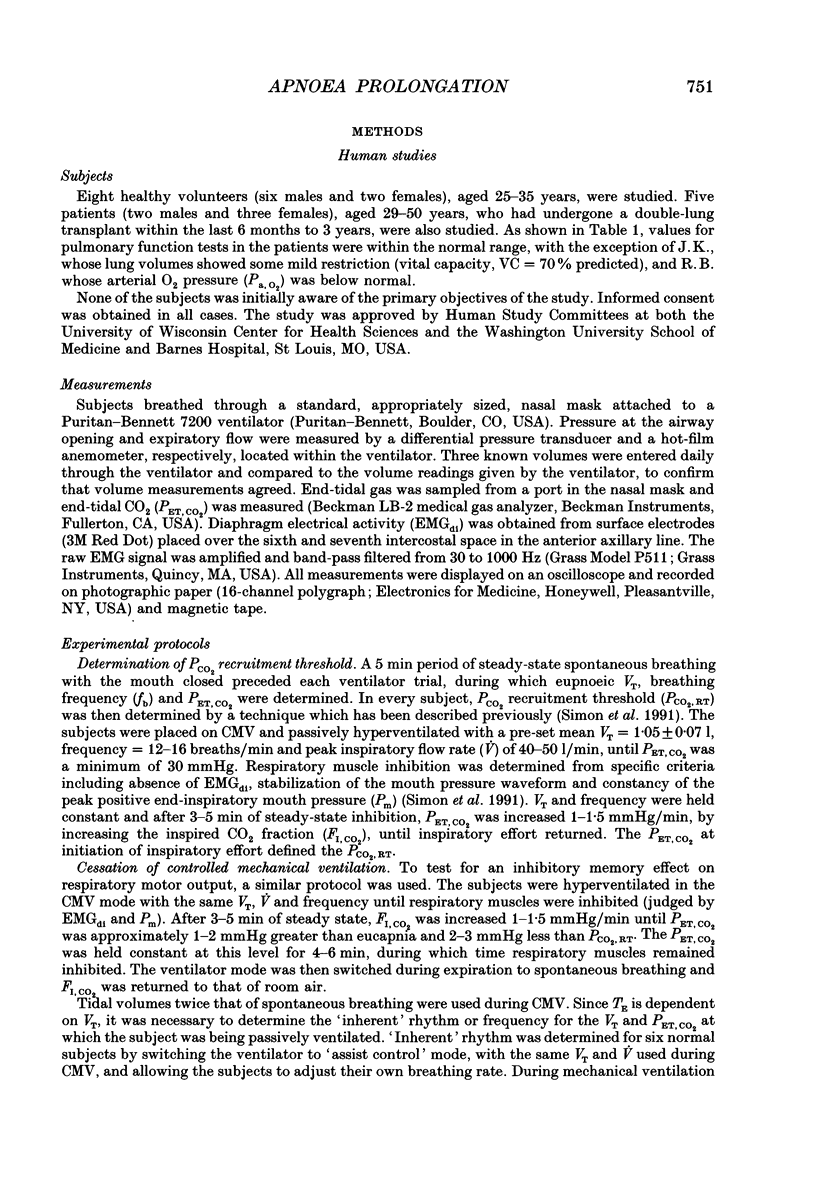
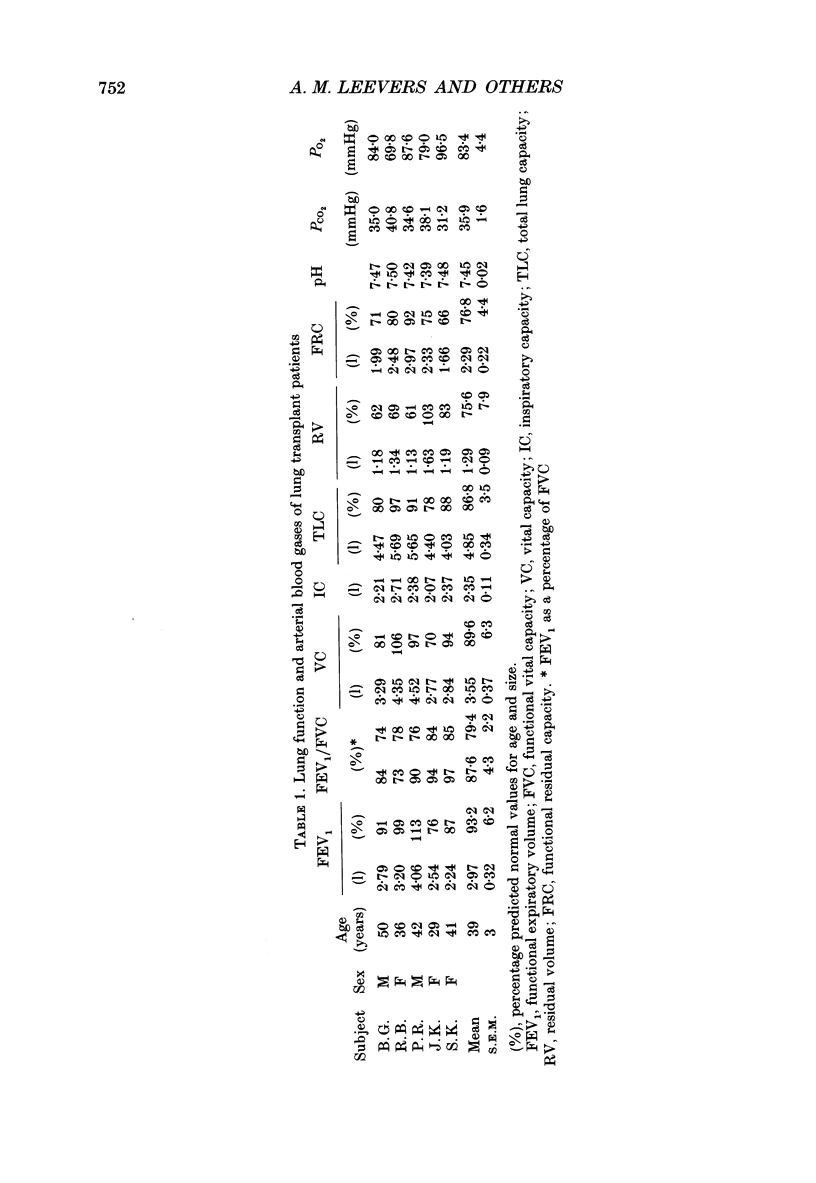
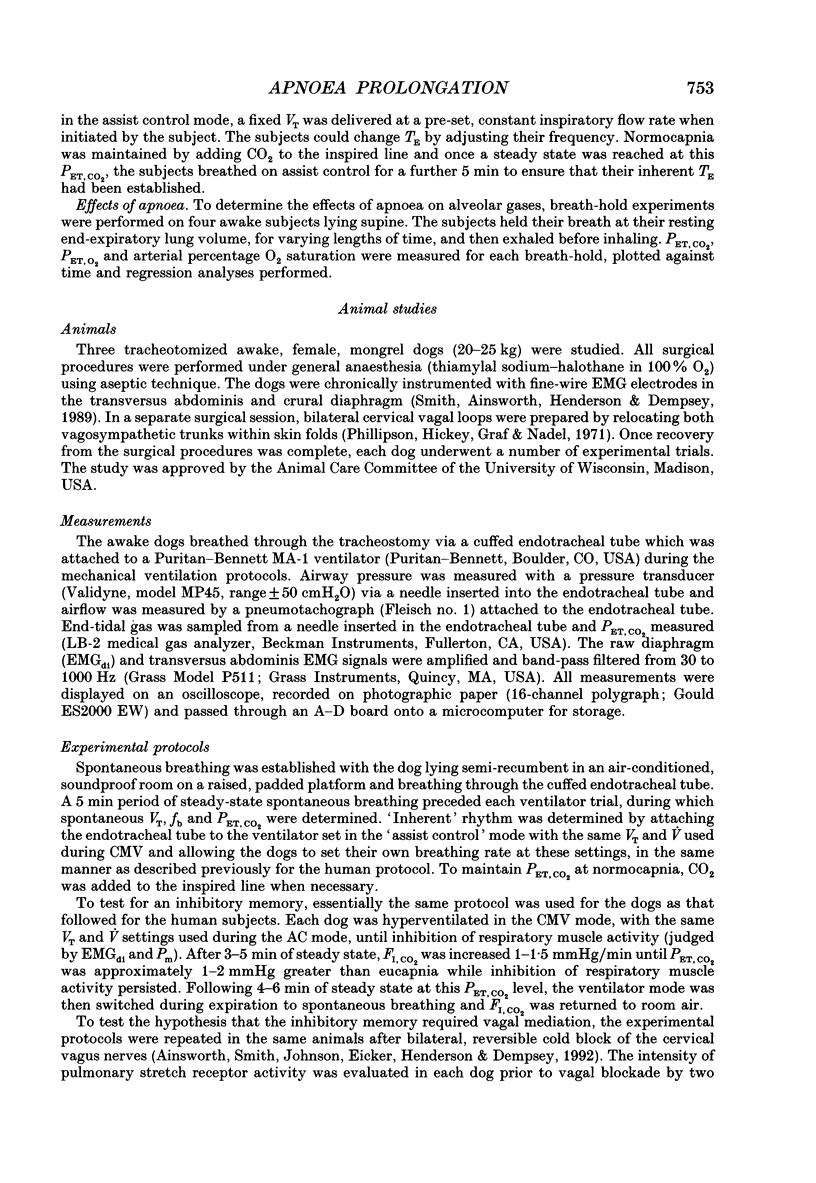
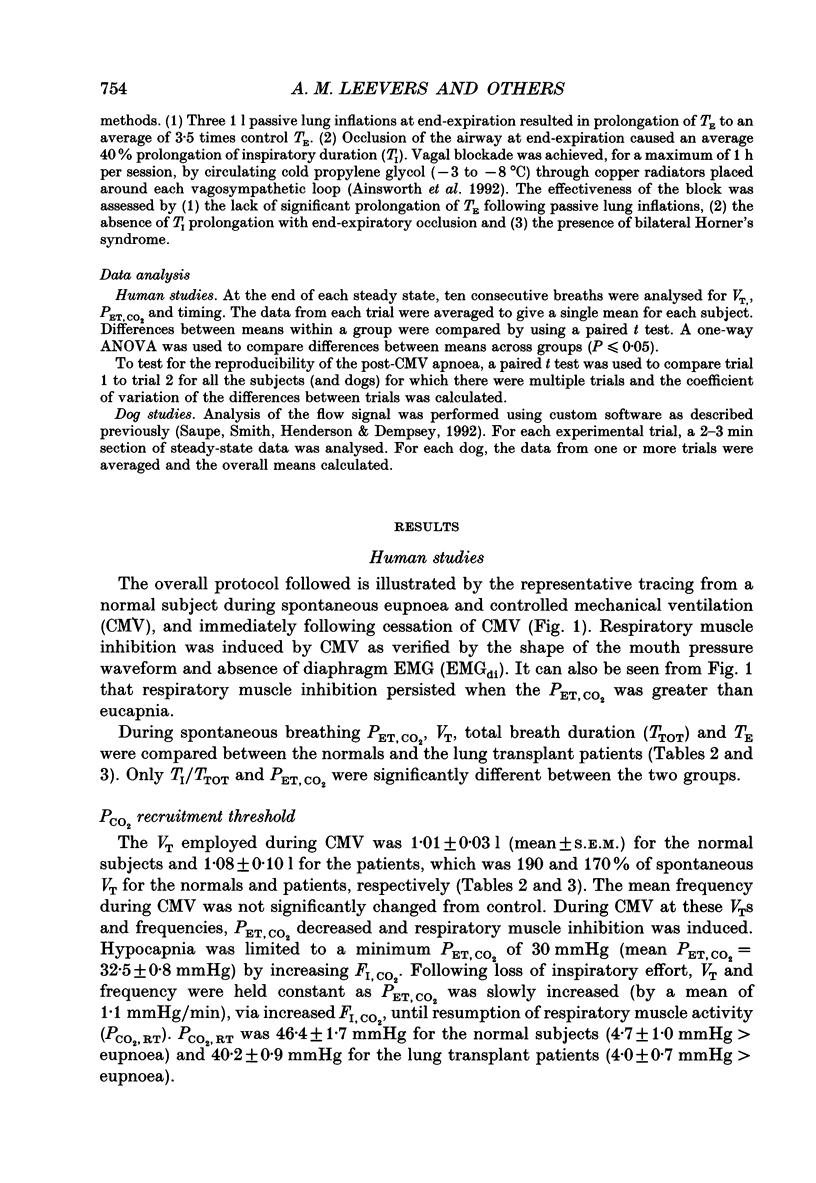
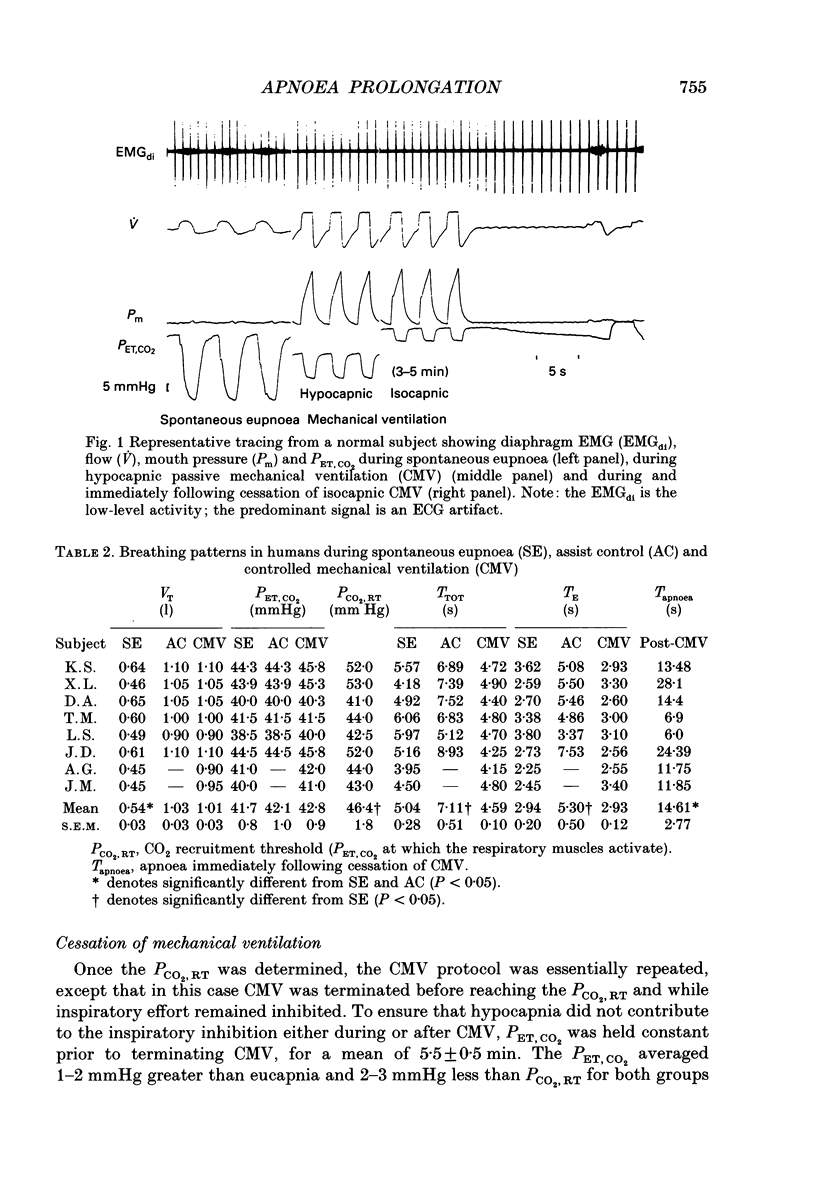
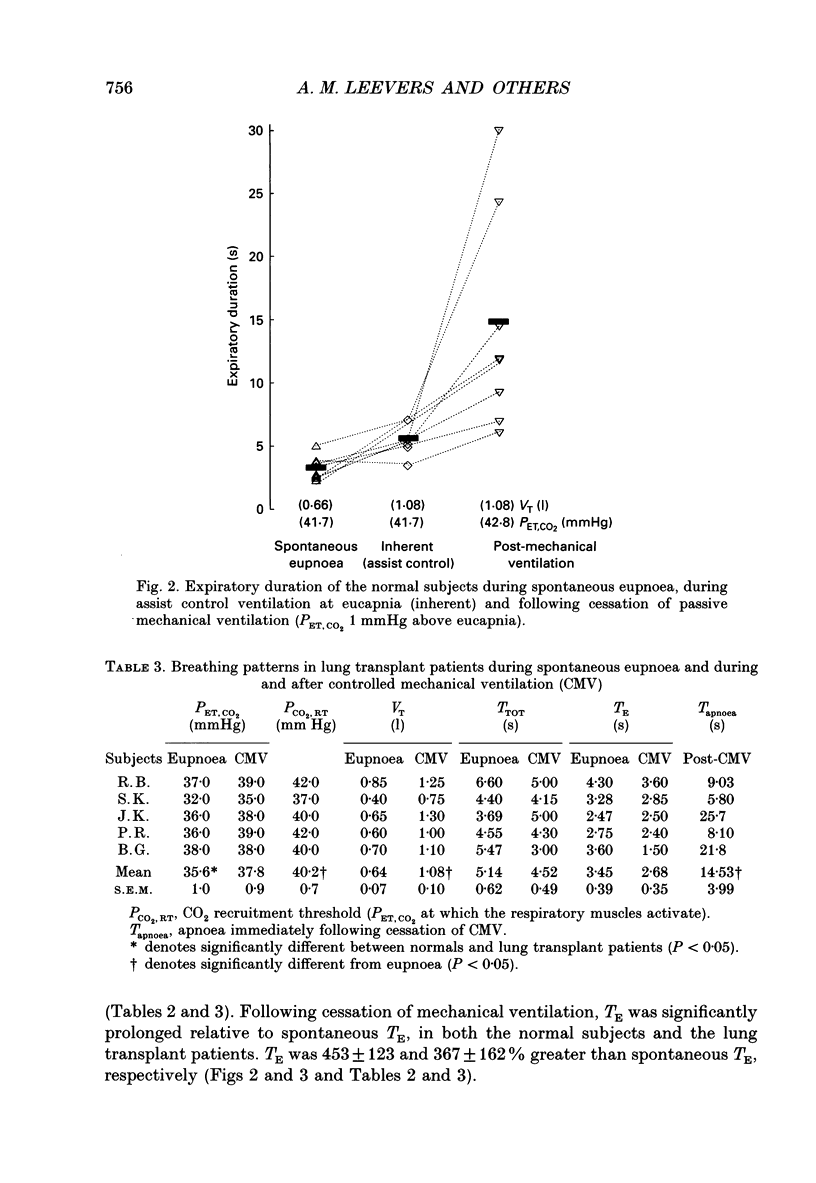
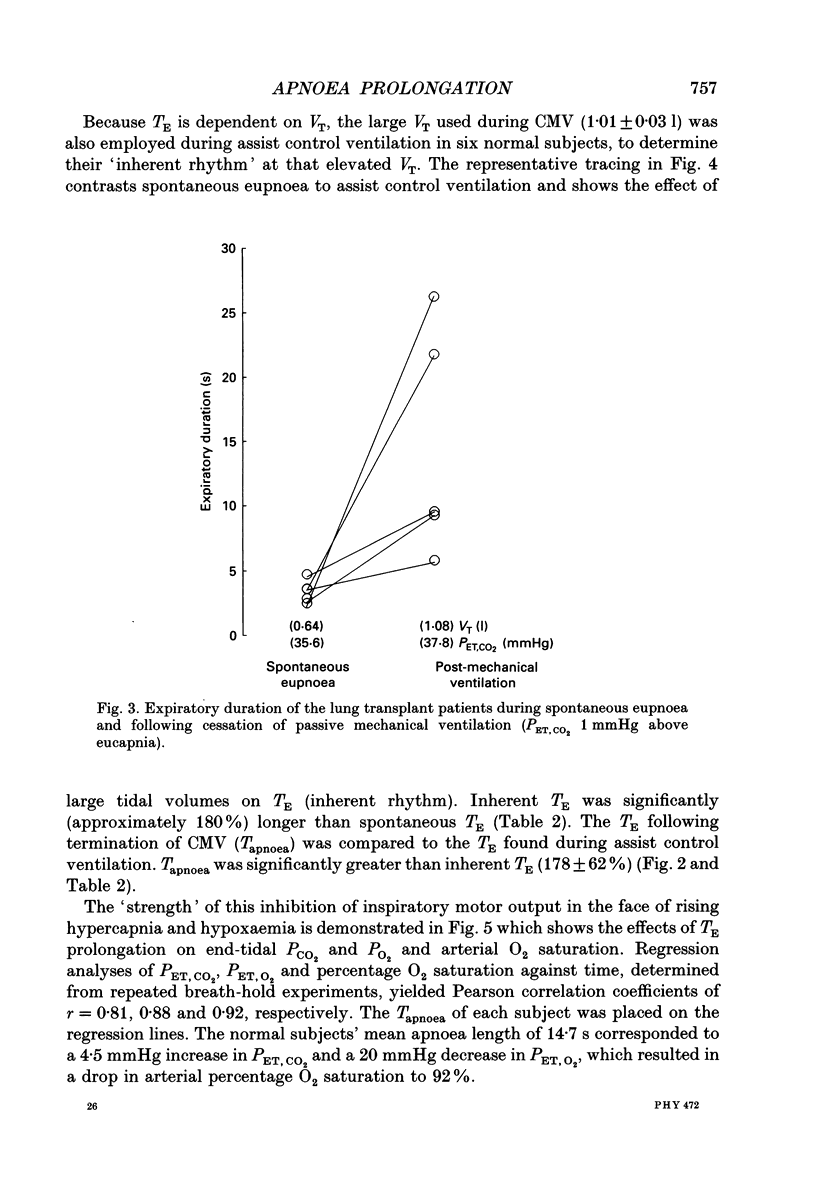
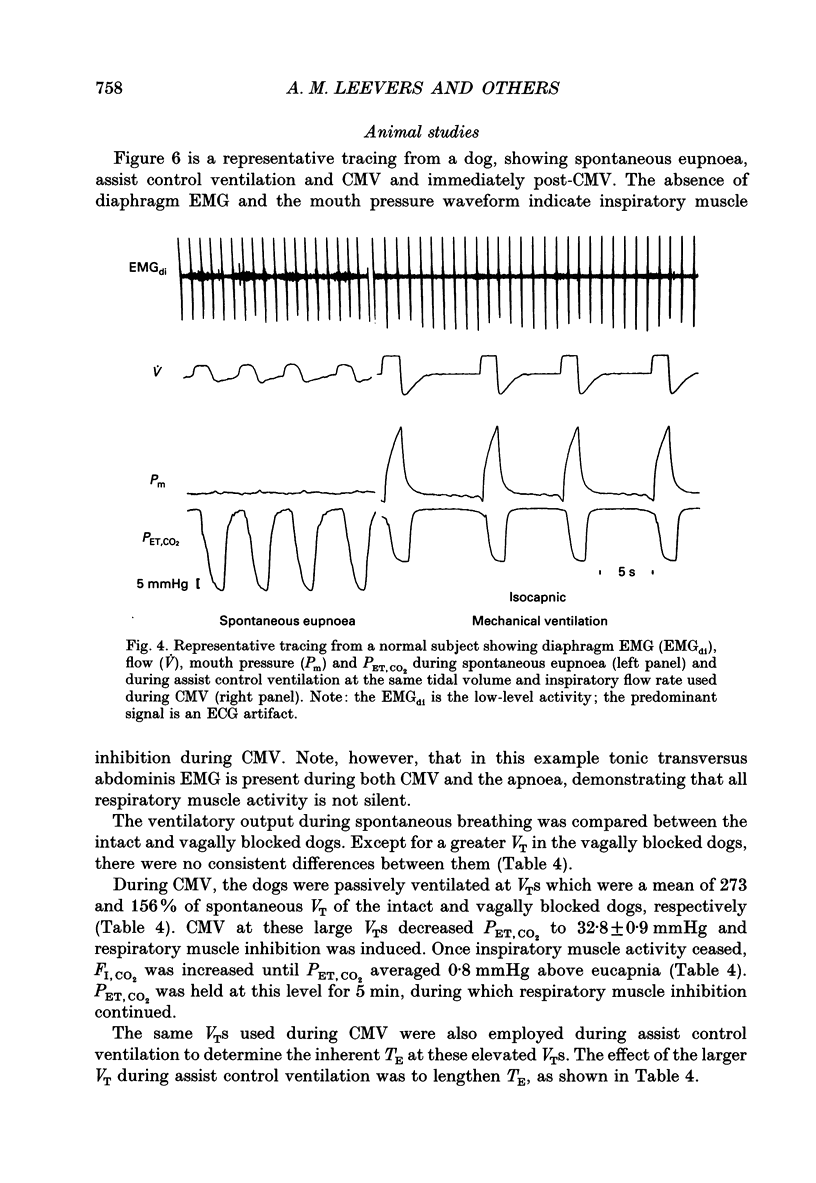
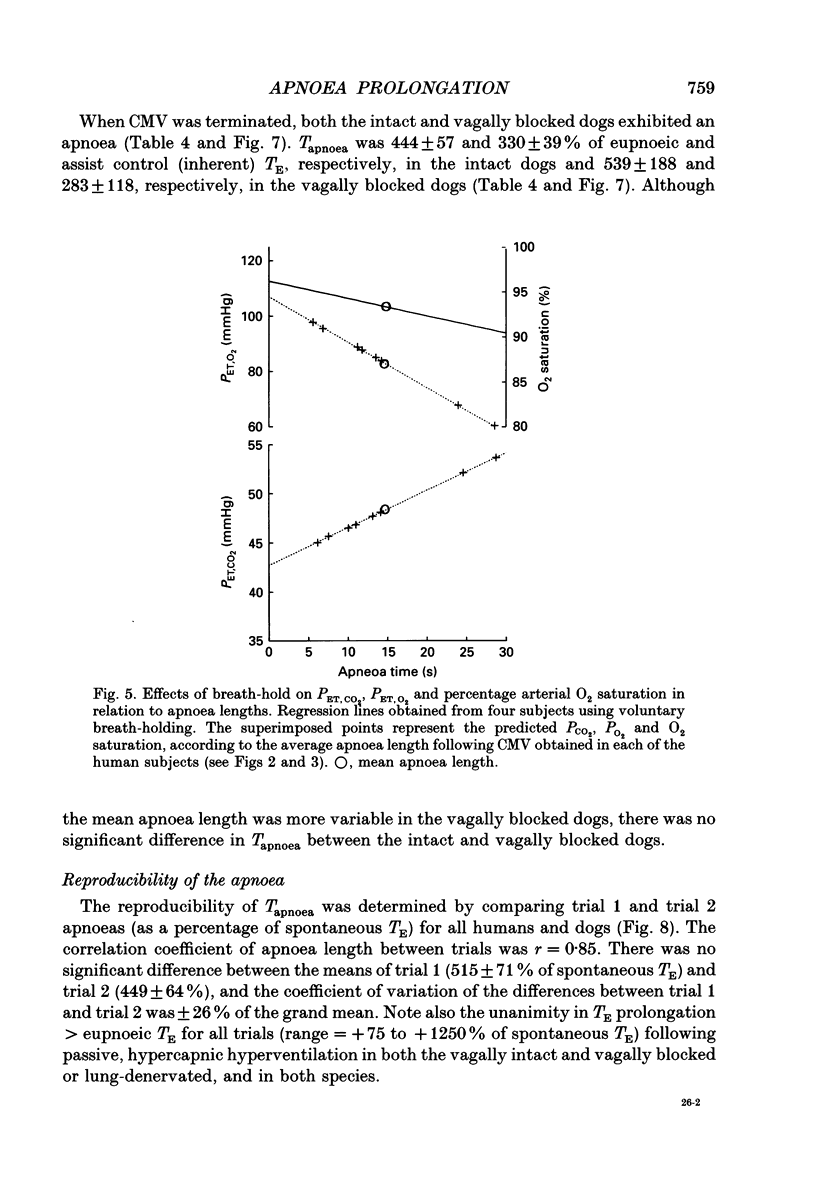
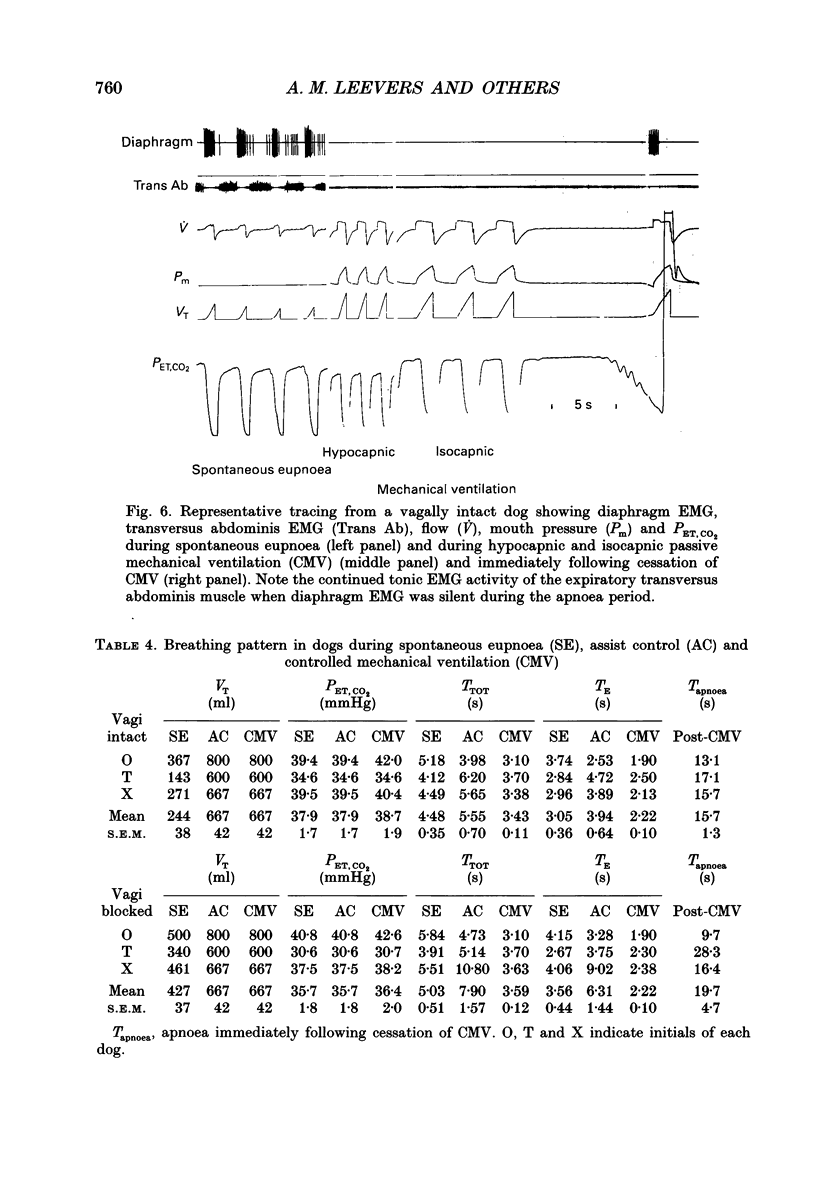
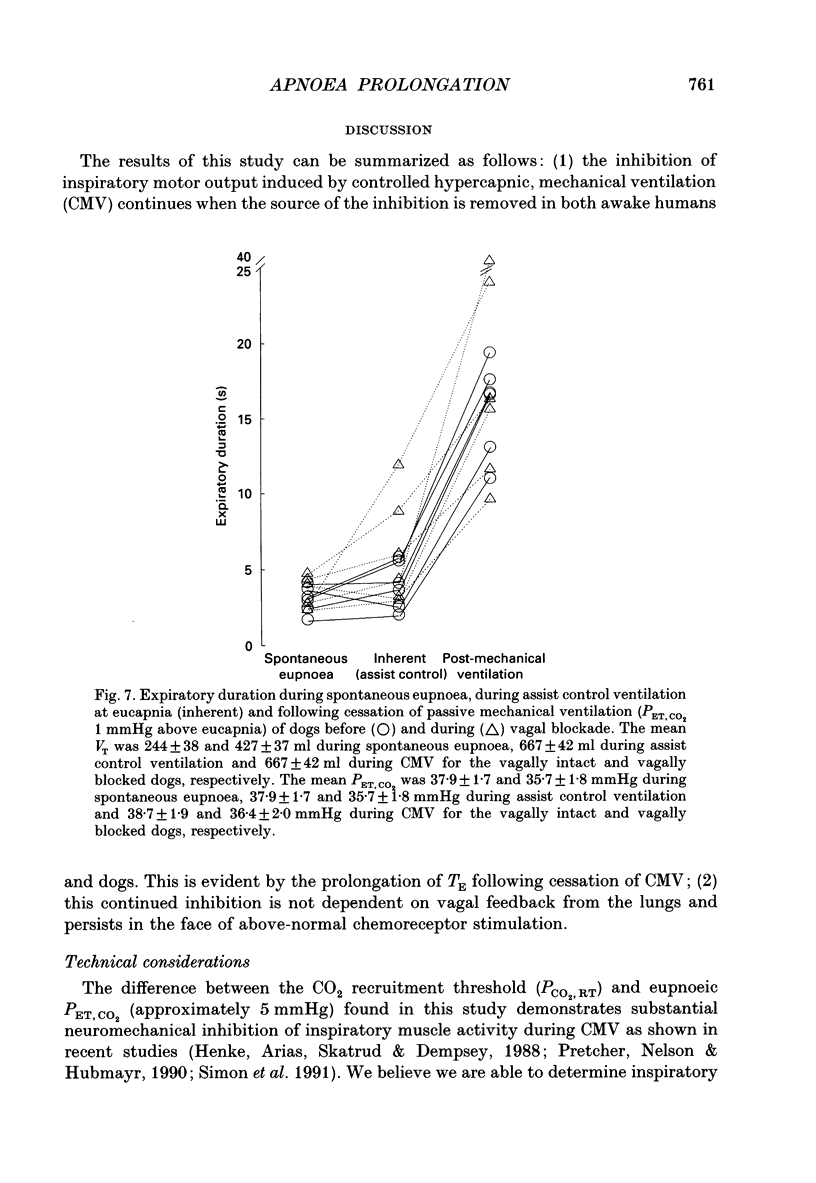
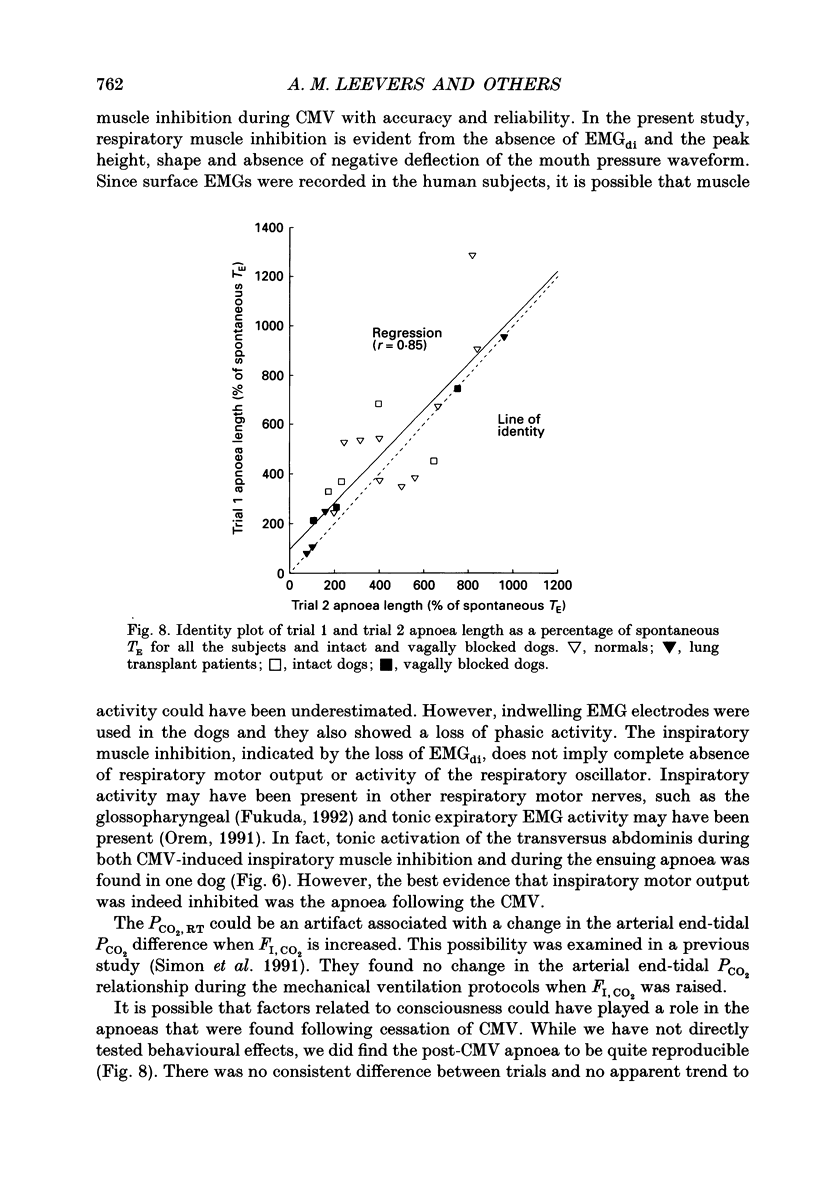
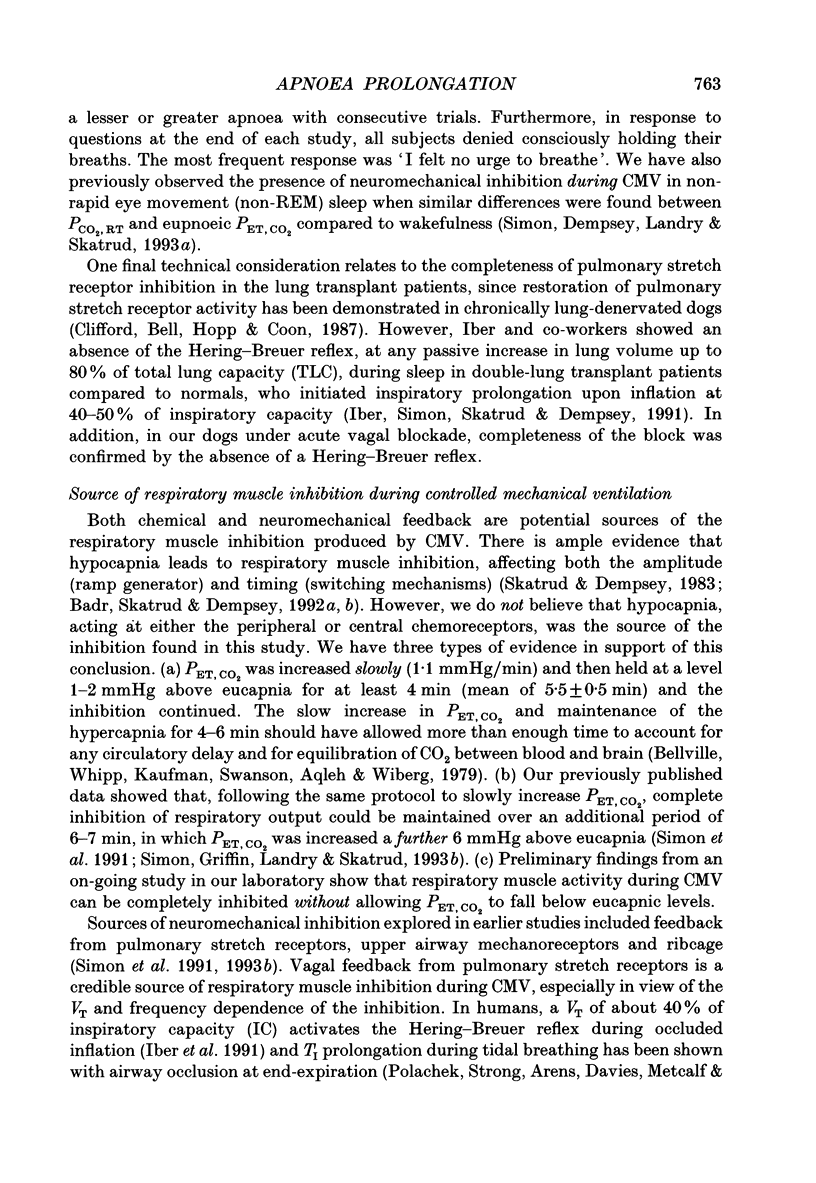
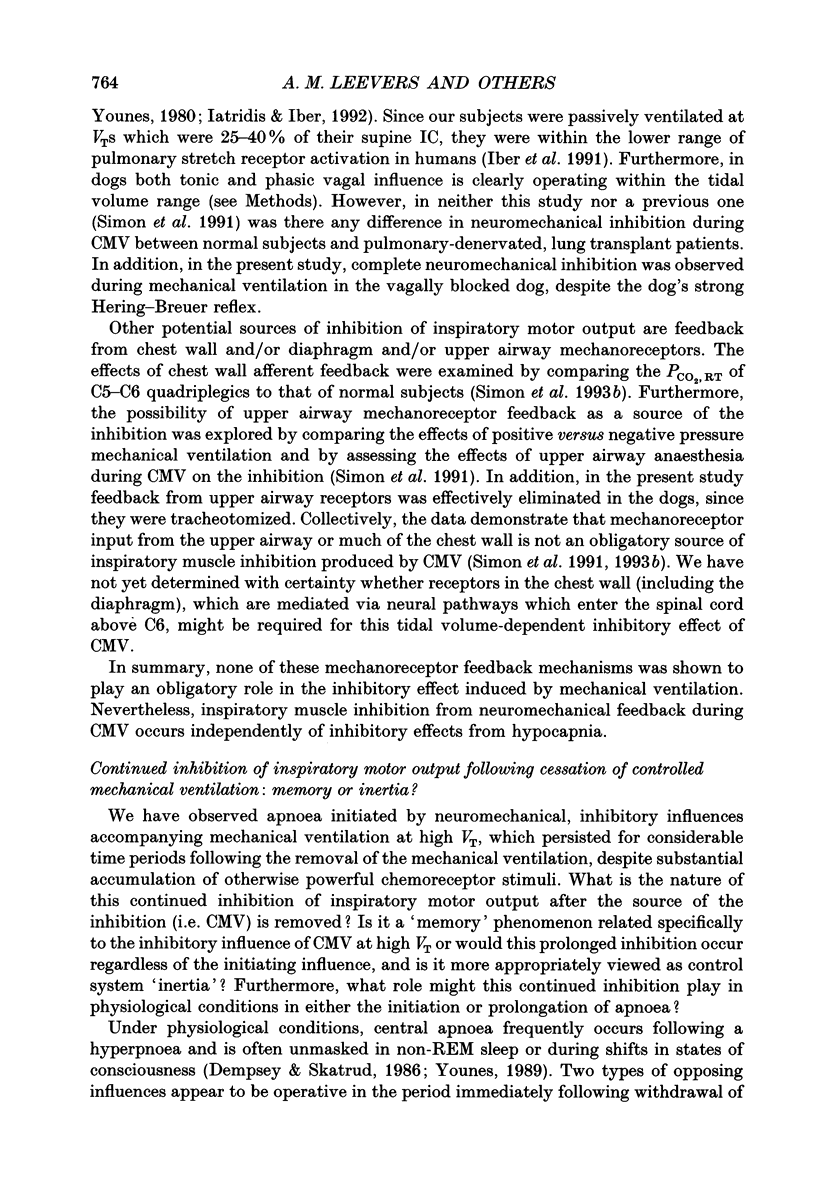
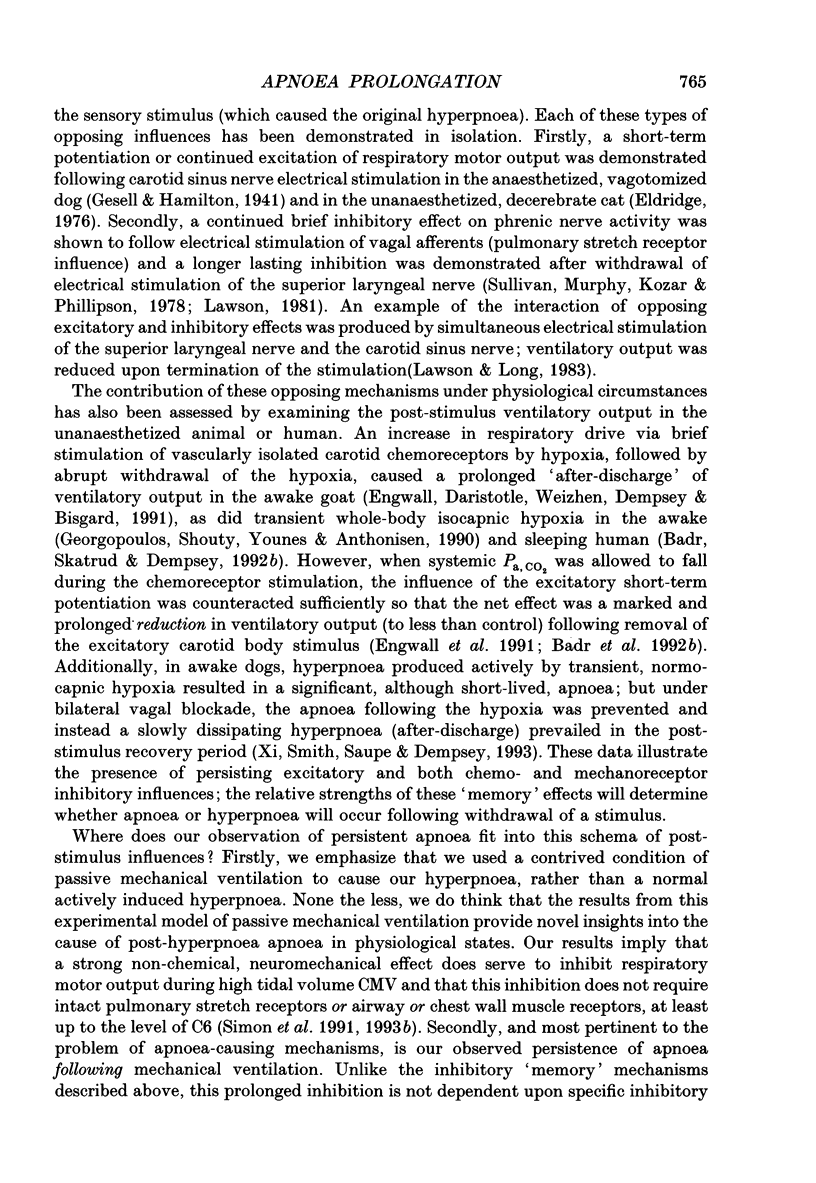
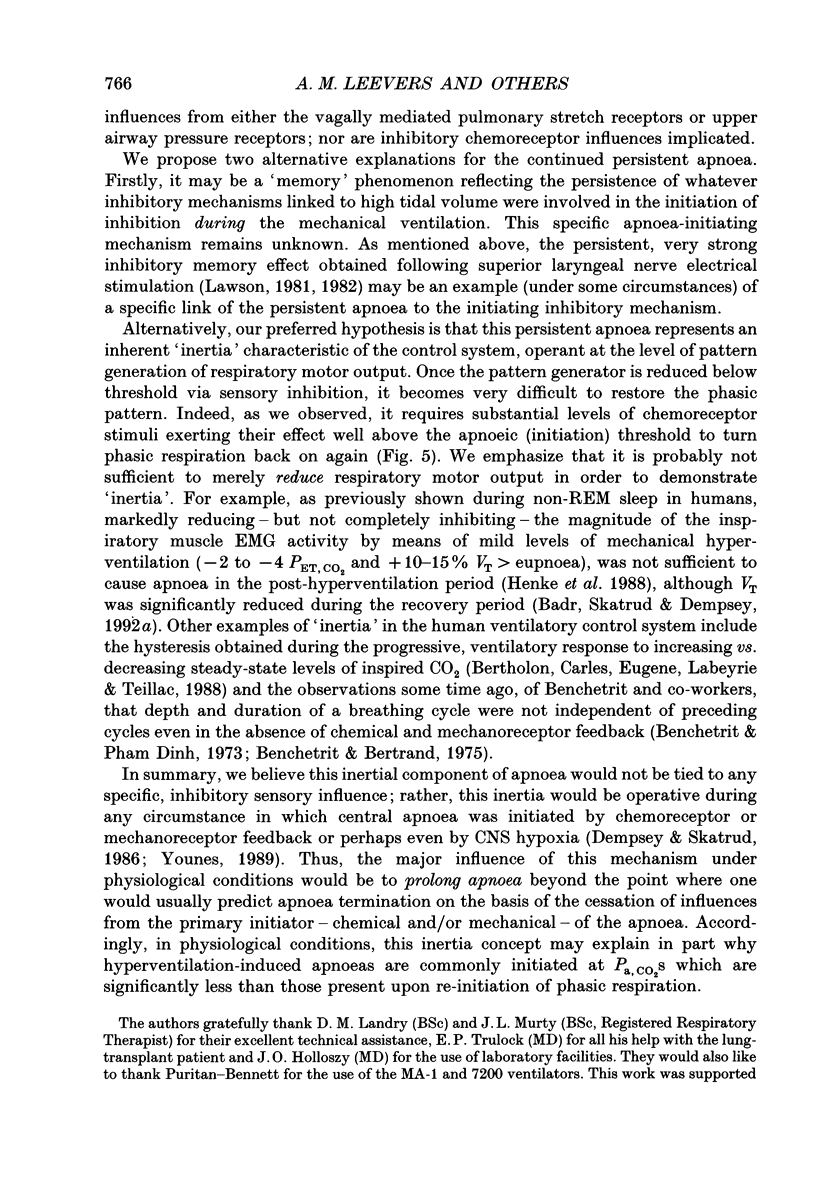
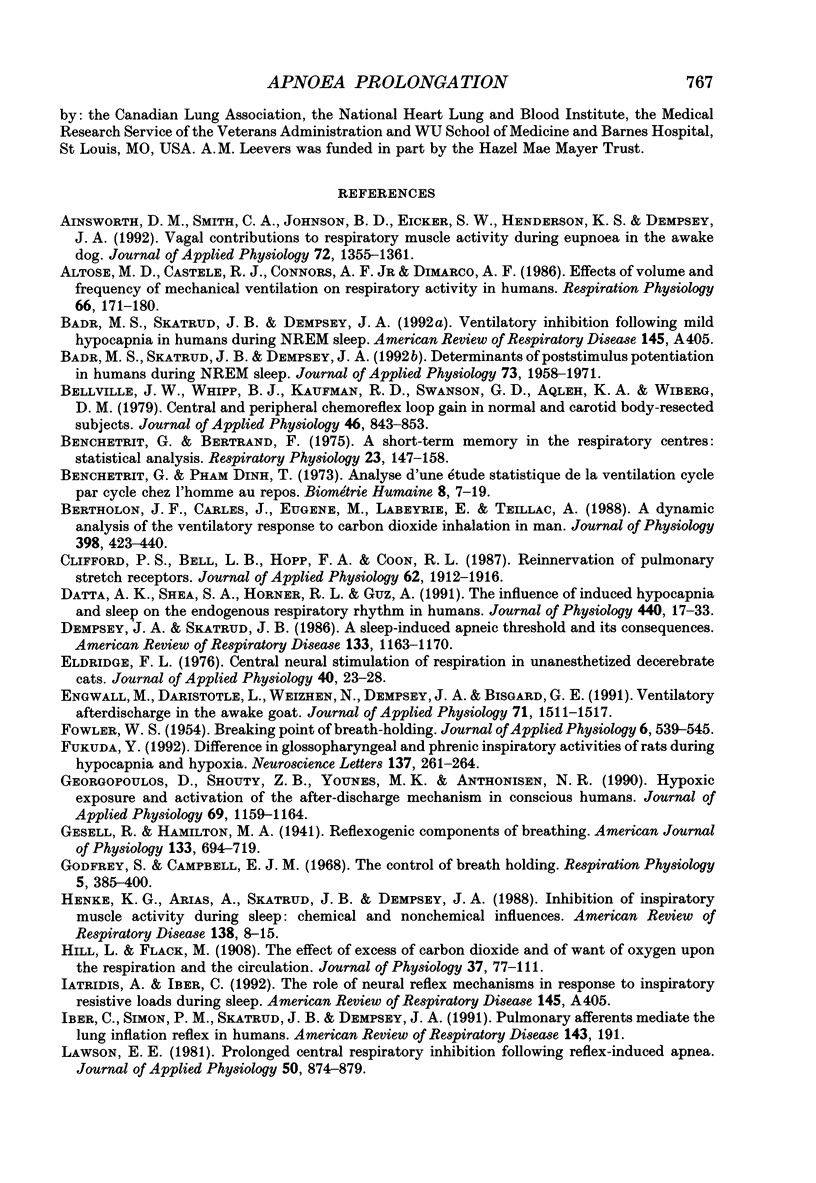
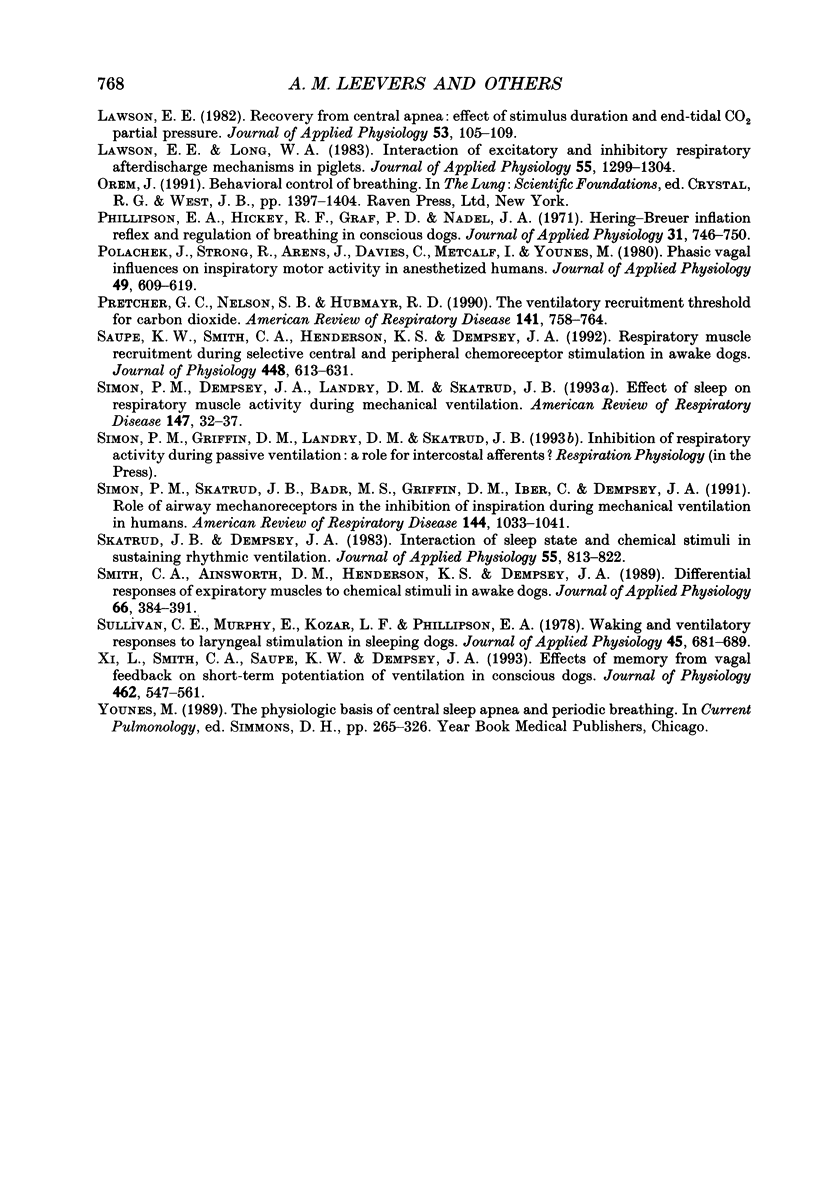
Selected References
These references are in PubMed. This may not be the complete list of references from this article.
- Ainsworth D. M., Smith C. A., Johnson B. D., Eicker S. W., Henderson K. S., Dempsey J. A. Vagal contributions to respiratory muscle activity during eupnea in the awake dog. J Appl Physiol (1985) 1992 Apr;72(4):1355–1361. doi: 10.1152/jappl.1992.72.4.1355. [DOI] [PubMed] [Google Scholar]
- Altose M. D., Castele R. J., Connors A. F., Jr, Dimarco A. F. Effects of volume and frequency of mechanical ventilation on respiratory activity in humans. Respir Physiol. 1986 Nov;66(2):171–180. doi: 10.1016/0034-5687(86)90070-8. [DOI] [PubMed] [Google Scholar]
- Badr M. S., Skatrud J. B., Dempsey J. A. Determinants of poststimulus potentiation in humans during NREM sleep. J Appl Physiol (1985) 1992 Nov;73(5):1958–1971. doi: 10.1152/jappl.1992.73.5.1958. [DOI] [PubMed] [Google Scholar]
- Bellville J. W., Whipp B. J., Kaufman R. D., Swanson G. D., Aqleh K. A., Wiberg D. M. Central and peripheral chemoreflex loop gain in normal and carotid body-resected subjects. J Appl Physiol Respir Environ Exerc Physiol. 1979 Apr;46(4):843–853. doi: 10.1152/jappl.1979.46.4.843. [DOI] [PubMed] [Google Scholar]
- Benchetrit G., Bertrand F. A short-term memory in the respiratory centres: statistical analysis. Respir Physiol. 1975 Mar;23(2):147–158. doi: 10.1016/0034-5687(75)90056-0. [DOI] [PubMed] [Google Scholar]
- Bertholon J. F., Carles J., Eugene M., Labeyrie E., Teillac A. A dynamic analysis of the ventilatory response to carbon dioxide inhalation in man. J Physiol. 1988 Apr;398:423–440. doi: 10.1113/jphysiol.1988.sp017051. [DOI] [PMC free article] [PubMed] [Google Scholar]
- Clifford P. S., Bell L. B., Hopp F. A., Coon R. L. Reinnervation of pulmonary stretch receptors. J Appl Physiol (1985) 1987 May;62(5):1912–1916. doi: 10.1152/jappl.1987.62.5.1912. [DOI] [PubMed] [Google Scholar]
- Datta A. K., Shea S. A., Horner R. L., Guz A. The influence of induced hypocapnia and sleep on the endogenous respiratory rhythm in humans. J Physiol. 1991;440:17–33. doi: 10.1113/jphysiol.1991.sp018693. [DOI] [PMC free article] [PubMed] [Google Scholar]
- Dempsey J. A., Skatrud J. B. A sleep-induced apneic threshold and its consequences. Am Rev Respir Dis. 1986 Jun;133(6):1163–1170. doi: 10.1164/arrd.1986.133.6.1163. [DOI] [PubMed] [Google Scholar]
- Eldridge F. L. Central neural stimulation of respiration in unanesthetized decerebrate cats. J Appl Physiol. 1976 Jan;40(1):23–28. doi: 10.1152/jappl.1976.40.1.23. [DOI] [PubMed] [Google Scholar]
- Engwall M. J., Daristotle L., Niu W. Z., Dempsey J. A., Bisgard G. E. Ventilatory afterdischarge in the awake goat. J Appl Physiol (1985) 1991 Oct;71(4):1511–1517. doi: 10.1152/jappl.1991.71.4.1511. [DOI] [PubMed] [Google Scholar]
- FOWLER W. S. Breaking point of breath-holding. J Appl Physiol. 1954 Mar;6(9):539–545. doi: 10.1152/jappl.1954.6.9.539. [DOI] [PubMed] [Google Scholar]
- Fukuda Y. Difference in glossopharyngeal and phrenic inspiratory activities of rats during hypocapnia and hypoxia. Neurosci Lett. 1992 Mar 30;137(2):261–264. doi: 10.1016/0304-3940(92)90418-7. [DOI] [PubMed] [Google Scholar]
- Georgopoulos D., Bshouty Z., Younes M., Anthonisen N. R. Hypoxic exposure and activation of the afterdischarge mechanism in conscious humans. J Appl Physiol (1985) 1990 Sep;69(3):1159–1164. doi: 10.1152/jappl.1990.69.3.1159. [DOI] [PubMed] [Google Scholar]
- Godfrey S., Campbell E. J. The control of breath holding. Respir Physiol. 1968 Oct;5(3):385–400. doi: 10.1016/0034-5687(68)90030-3. [DOI] [PubMed] [Google Scholar]
- Henke K. G., Arias A., Skatrud J. B., Dempsey J. A. Inhibition of inspiratory muscle activity during sleep. Chemical and nonchemical influences. Am Rev Respir Dis. 1988 Jul;138(1):8–15. doi: 10.1164/ajrccm/138.1.8. [DOI] [PubMed] [Google Scholar]
- Hill L., Flack M. The effect of excess of carbon dioxide and of want of oxygen upon the respiration and the circulation. J Physiol. 1908 Jun 30;37(2):77–111. doi: 10.1113/jphysiol.1908.sp001258. [DOI] [PMC free article] [PubMed] [Google Scholar]
- Lawson E. E., Long W. A. Interaction of excitatory and inhibitory respiratory afterdischarge mechanisms in piglets. J Appl Physiol Respir Environ Exerc Physiol. 1983 Oct;55(4):1299–1304. doi: 10.1152/jappl.1983.55.4.1299. [DOI] [PubMed] [Google Scholar]
- Lawson E. E. Prolonged central respiratory inhibition following reflex-induced apnea. J Appl Physiol Respir Environ Exerc Physiol. 1981 Apr;50(4):874–879. doi: 10.1152/jappl.1981.50.4.874. [DOI] [PubMed] [Google Scholar]
- Lawson E. E. Recovery from central apnea: effect of stimulus duration and end-tidal CO2 partial pressure. J Appl Physiol Respir Environ Exerc Physiol. 1982 Jul;53(1):105–109. doi: 10.1152/jappl.1982.53.1.105. [DOI] [PubMed] [Google Scholar]
- Phillipson E. A., Hickey R. F., Graf P. D., Nadel J. A. Hering-Breuer inflation reflex and regulation of breathing in conscious dogs. J Appl Physiol. 1971 Nov;31(5):746–750. doi: 10.1152/jappl.1971.31.5.746. [DOI] [PubMed] [Google Scholar]
- Polacheck J., Strong R., Arens J., Davies C., Metcalf I., Younes M. Phasic vagal influence on inspiratory motor output in anesthetized human subjects. J Appl Physiol Respir Environ Exerc Physiol. 1980 Oct;49(4):609–619. doi: 10.1152/jappl.1980.49.4.609. [DOI] [PubMed] [Google Scholar]
- Prechter G. C., Nelson S. B., Hubmayr R. D. The ventilatory recruitment threshold for carbon dioxide. Am Rev Respir Dis. 1990 Mar;141(3):758–764. doi: 10.1164/ajrccm/141.3.758. [DOI] [PubMed] [Google Scholar]
- Saupe K. W., Smith C. A., Henderson K. S., Dempsey J. A. Respiratory muscle recruitment during selective central and peripheral chemoreceptor stimulation in awake dogs. J Physiol. 1992 Mar;448:613–631. doi: 10.1113/jphysiol.1992.sp019061. [DOI] [PMC free article] [PubMed] [Google Scholar]
- Simon P. M., Dempsey J. A., Landry D. M., Skatrud J. B. Effect of sleep on respiratory muscle activity during mechanical ventilation. Am Rev Respir Dis. 1993 Jan;147(1):32–37. doi: 10.1164/ajrccm/147.1.32. [DOI] [PubMed] [Google Scholar]
- Simon P. M., Skatrud J. B., Badr M. S., Griffin D. M., Iber C., Dempsey J. A. Role of airway mechanoreceptors in the inhibition of inspiration during mechanical ventilation in humans. Am Rev Respir Dis. 1991 Nov;144(5):1033–1041. doi: 10.1164/ajrccm/144.5.1033. [DOI] [PubMed] [Google Scholar]
- Skatrud J. B., Dempsey J. A. Interaction of sleep state and chemical stimuli in sustaining rhythmic ventilation. J Appl Physiol Respir Environ Exerc Physiol. 1983 Sep;55(3):813–822. doi: 10.1152/jappl.1983.55.3.813. [DOI] [PubMed] [Google Scholar]
- Smith C. A., Ainsworth D. M., Henderson K. S., Dempsey J. A. Differential responses of expiratory muscles to chemical stimuli in awake dogs. J Appl Physiol (1985) 1989 Jan;66(1):384–391. doi: 10.1152/jappl.1989.66.1.384. [DOI] [PubMed] [Google Scholar]
- Sullivan C. E., Murphy E., Kozar L. F., Phillipson E. A. Waking and ventilatory responses to laryngeal stimulation in sleeping dogs. J Appl Physiol Respir Environ Exerc Physiol. 1978 Nov;45(5):681–689. doi: 10.1152/jappl.1978.45.5.681. [DOI] [PubMed] [Google Scholar]
- Xi L., Smith C. A., Saupe K. W., Dempsey J. A. Effects of memory from vagal feedback on short-term potentiation of ventilation in conscious dogs. J Physiol. 1993 Mar;462:547–561. doi: 10.1113/jphysiol.1993.sp019568. [DOI] [PMC free article] [PubMed] [Google Scholar]


